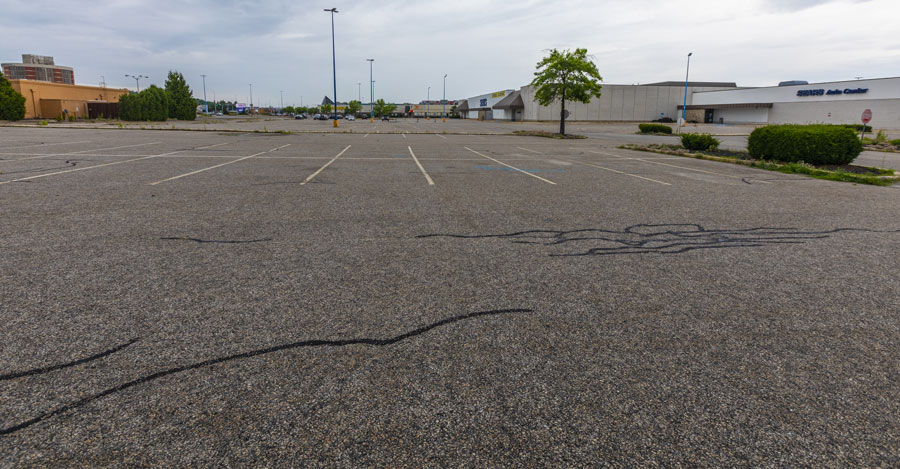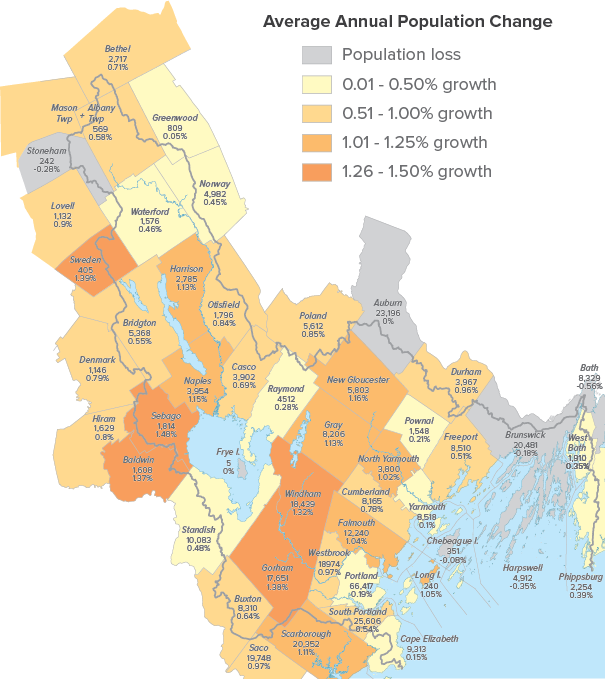New Suburban Construction Eats into Forests and Agricultural Lands
Population of Casco Bay Watershed Grew Nearly 10 Percent in 18 Years
WHY IT MATTERS
Broad social and economic trends, including population growth, contribute to changing patterns in where people work and live in the Casco Bay region and, in turn, the intensity of human impacts. Many environmental stressors affecting the Bay stem from changes in land use in the watershed, particularly the conversion of undeveloped areas such as fields and forests to roads, buildings, parking lots, and driveways. These impervious surfaces cause more precipitation to run off the land, carrying pollutants into streams and lakes. Suburban sprawl contributes to degraded aquatic ecosystems, fragmentation of forests, loss of access to open space, and declines in fish and wildlife habitat.

Darker orange indicates higher rates of population growth from 2000 to 2018. For each municipality, the map lists population in 2018 and average annual percent change. Source: IPUMS NHGIS, University of Minnesota
STATUS
Between 2000 and 2018, the combined population of the municipalities making up the Casco Bay watershed grew by an estimated 9.9% (33,678). Communities in closer proximity to the urban core of Portland had the largest increases in population.In a continuation of recent trends, the total area of forested and agricultural lands in the watershed declined by 3.35 square miles from 2011 to 2016. The total area of developed lands expanded by 1.13 square miles.
successes & challenges
- Individual towns and cities have been successful in applying Smart Growth approaches to balance economic growth and development with agricultural, forestry, open space, and other community values, but home-rule decision making results in irregular regional growth and development patterns.
- Many land use planning and conservation tools such as comprehensive planning, open space planning, conservation subdivision design, and wetland and shoreland zoning are available to guide local development while protecting water quality and habitat. Casco Bay communities can choose where and how to direct growth through planning and land use ordinances.
- Within the region, ample opportunities exist for redevelopment in growth areas and for allowing increased density to accommodate development that does not expand impervious surfaces. However, regulations aimed at restoring impaired water bodies may create disincentives for doing so.
- Many challenges such as urban sprawl and traffic congestion are regional in nature, but towns handle solutions quite differently. Better support and funding for regional planning is greatly needed to provide technical assistance on a regional level for issues related to transportation and open space planning.
View a PDF version of this page that can be downloaded and printed.
View references, further reading, and a summary of methods and data sources.
Selected data and data analysis code for certain indicators are available for review.
STATE OF CASCO BAY
Drivers & Stressors
What’s Affecting the Bay?
Human Connections
What’s Being Done?
If you would like to receive a printed State of Casco Bay report, send an email request to cbep@maine.edu.
This document has been funded by the U.S. Environmental Protection Agency under Cooperative Agreements #CE00A00348-0 and #CE00A00662-0 with the University of Southern Maine.
Suggested citation: Casco Bay Estuary Partnership. State of Casco Bay, 6th Edition (2021).
Acknowledgments
Photo at top of page: Jerry Monkman, Ecophotography.com